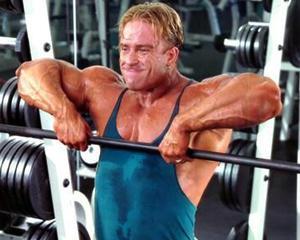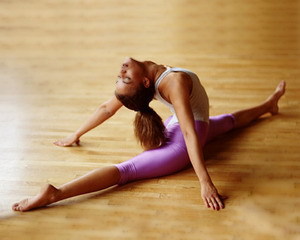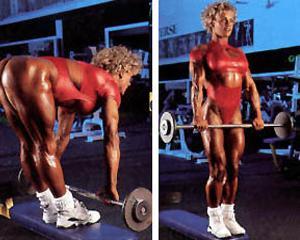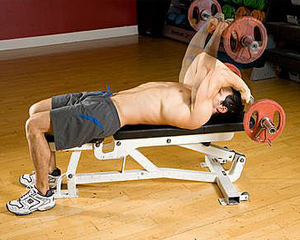DRAW DUTY IN TILT
 Dumbbell in the slope refers to the basic exercises in bodybuilding and fitness, as it affects a large array of muscles. Exercise will be extremely useful for eliminating possible asymmetry in development, as well as perfectly develop the latissimus muscles, the entire top of the back, will include the biceps, forearm, and even the posterior deltoid bundle.
Dumbbell in the slope refers to the basic exercises in bodybuilding and fitness, as it affects a large array of muscles. Exercise will be extremely useful for eliminating possible asymmetry in development, as well as perfectly develop the latissimus muscles, the entire top of the back, will include the biceps, forearm, and even the posterior deltoid bundle.
And besides progress in bodybuilding, doing dumbbell traction in the slope will improve your results in many other sports, for example, in swimming, tennis, basketball, martial arts, archery and others.
Technique performing dumbbell tilt
There are two main ways to perform dumbbell traction in the slope. In the first version, you lean on a horizontal bench with your arm and leg bent at the knee. And in the second, you remain standing on the floor with your legs wide apart, next to the bench, and you only rest your hand on it. But regardless of the method chosen, the technique of execution remains unchanged.
Proper exercise technique:
1. Take a neutral grip (so that the palm was turned to the thigh) dumbbell from the floor with his right hand. Choose any of the 2 options for setting the legs and rest your left hand on the bench. Tilt the body until parallel with the floor and slightly bend at the waist. Dumbbell arm fully straighten and slightly lower the right shoulder. This is the starting position.
2. Inhale, and, holding your breath, pull the dumbbell along the arcuate path as high as possible. When the elbow reaches shoulder level, then continue to raise the elbow together with the shoulder, and at the top of the movement try to bring the shoulder blades together and pause – all this will help minimize working muscles.
3. After a pause, as you exhale, gently lower the dumbbell to its original position. And do the required number of repetitions.
4. After working one side, set for the other half of the back.
It is important:
Dumbbell movement occurs only due to bending in the elbow and shoulder joints. Raise and lower the dumbbell smoothly and so that the forearms are always perpendicular to the floor.
Try not to pull the dumbbell work biceps, one way or another, they will participate in this movement, but try to minimize their contribution.
Do not throw weight due to the rotation of the body, the back during the exercise should remain fixed. Otherwise it is fraught with injury.
Hold the torso parallel to the ground, do not round the back – violation of these rules will reduce the effectiveness of the exercise and also traumatic.
If you can not lift the dumbbell, so that the elbow rises above the shoulder, then you need to take less weight, otherwise the muscles will not work at maximum amplitude, which means the effect of the exercise will be small.
Experiment with grip dumbbells to achieve the highest quality muscle work.
Working muscles when dumbbell in the slope
the latissimus dorsi
the muscles of the upper back (including the trapezium, rhomboid, and large and small round)
biceps
shoulder muscles
back of the deltoid muscles
forearm




